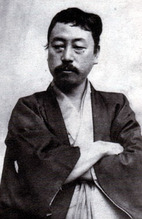
The Book of Tea Okakura Kakuzo [ excerpt ]
(Intro by Liza Dalby)
The Cup of Humanity:
The Tea Room
Definitely interesting ideas - I had never thought about why we (in the WEST) have decorations that reflect the purpose of the room - how it is weird to have these mirrored thoughts. I wonder about the details of the tea - but that is something I can never tred upon...
(Intro by Liza Dalby)
- When first written, “The Book of Tea” was only really meant for a small group of people - but it’s popular has grown over time (especially in the “West”).
- Meant for “narrow elite, who might be expected to join in his protest against the spiritual misunderstandings that separated the East and West.”
- Trying to change tea from “cult of Japan” into something more meaningful (art, harmonious with daily life, natural...)
The Cup of Humanity:
- Teaism: religious aestheticism of tea (cult focussing on beauty in life), not materialistic
- Philosophy of Tea: beyond aestheticism, deals with ethics, religion, view on man and nature.
- Art, such as Teaism has not been appreciated as it should (it seems to trivial in the eyes of many who do not see simple/subtle things in life)
- The West has many ideas of the “East” due to the lack of effort in understanding. However the East also has an image of the “West” (“most impractical people on the earth”)
- Though some barriers between were attempted to be overridden it did not necessarily work. Mostly materialistic interaction...(fashion, consumer goods)
- For the purpose of better understanding, Kakuzo is saying this bluntly: “Unfortunately the Western attitude is unfavorable to the understanding of East...”
- “no tea” in the constitution of the “west” (despite the fact that there is definite tea culture)
- While tea was spreading over the world, it was met with opposition (some said “filthy custom”, loss of “comeliness” and beauty).
- West and Eat can meet in the recognition of the Imperfect.
The Tea Room
- Sukiya - humble (made of bamboo and wood, straw hut)
- apparently barren due to its simplicity
- tea room, portico, garden path (steps toward enlightenment)
- good tea room should cost more than a mansion (workers, materials etc)
- a tea room can displace you (from city to forest - arousal of the senses)
- the small door into the tea room is to level hierarchy of people (through humiliation)
- if there is dust- you are not a tea master
- the tea room is made FOR the tea master (not the other way around)
- However with zen and buddhist ideals, the tea room/house became only a temporary refuge for the body (rather than a deeper connection)
- inspired by the zen monastery tea room (bare except for alcove) - simplicity!
- There should only be one changing aspect (focus/appreciation) vs. WEST many, stationary
- Tea culture has been finely crafted - all aspects thought out
- Taoist/Zen ideals of perfection is more about the process (therefore guests are left to imagination to complete the effect of the space “in relation to himself”)
- In Western homes things are ruled by symmetry and repetition (why do we have a portraits, food pictures, flower pictures in a room with all of those items in it already?)
Definitely interesting ideas - I had never thought about why we (in the WEST) have decorations that reflect the purpose of the room - how it is weird to have these mirrored thoughts. I wonder about the details of the tea - but that is something I can never tred upon...
 RSS Feed
RSS Feed